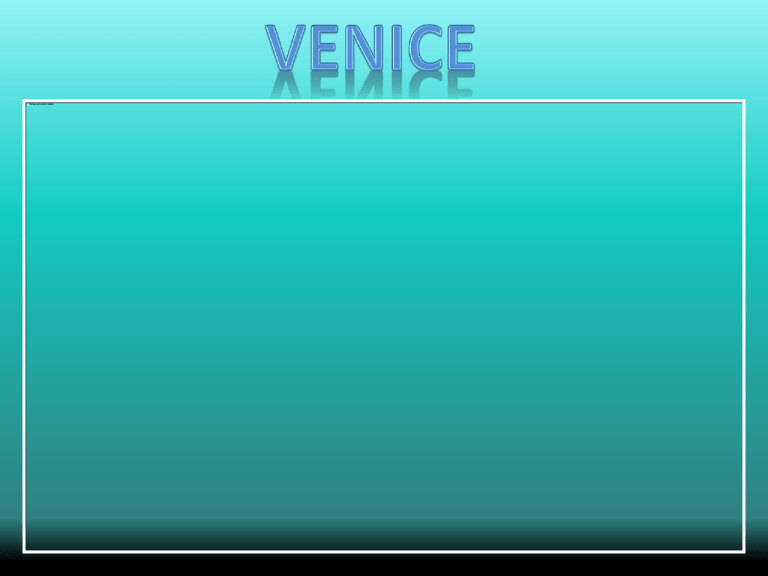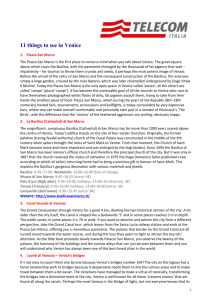Document
advertisement

Once the center of a prosperous empire, Venice is a unique city and one of the historic and artistic treasures of the world. The historic center is comprised of 118 islands separated by canals that are joined together by a multitude of bridges. In the 5th century AD , a group of island communities situated in the middle of a vast tidal lagoon at the northern end of the Adriatic Sea banded together for mutual defense. In the 8th century the Pope recognized the authority of their elected leader, the Doge. The islands of Venice were low and were comprised mainly of sandy soil. As the city grew, heavy structures were built on wooden pilings driven into the soft mud and sand to prevent them from sinking. An important city needed the protection of an important saint. In 828, merchants from Venice stole the remains of Saint Mark from Alexandria, the site of his martyrdom and burial. The remains were supposedly smuggled in a basket beneath a layer of pork to discourage close examination by Moslem inspectors. From the 8th to 12th century Venice evolved into a powerful maritime republic. Trade with the Islamic world and the Byzantine Empire to the east gave it riches enough to build a powerful fleet. War galleys were mass-produced at the Arsenale di Venezia, the huge, state-owned shipyard. At the peak of it’s power Venice had 3,300 ships of various types, and dominated trade in the Mediterranean sea. The city-state exerted control over large portions of northern Italy, Crete, Cyprus, most of the Greek Islands, and numerous outposts in Europe and the Middle-east. During the Fourth Crusade in 1204, Venetian and Crusader forces conquered Constantinople. The sack of the city resulted in widespread rape, slaughter and pillage. Vast sums of money were returned to Venice. The four horses on the façade of Saint Mark’s Cathedral were seized from the Hippodrome of Constantinople In 1570, Venice joined Pope Pius V’s Holy League. This coalition of many of the Catholic powers of the Mediterranean was assembled to combat the expanding naval power of the Ottoman Empire. In 1571, the Christian fleet defeated the Ottoman fleet in a battle which effectively ended Moslem domination of the Mediterranean. In the 17th century, Portuguese traders began to ship goods around Africa which previously came into Europe by way of Venice. In the 18th century competition from neighboring Trieste and Livorno on the west coast greatly reduced Venice’s domination of the commercial traffic of the Mediterranean. In 1797, French armies commanded by Napoleon Bonaparte conquered Venice and most of Italy. For the next 17years, Napoleon was to dominate Italy, either directly or through client states, often ruled by relatives. Venice became part of Austria’s dominions after Napoleon’s downfall in 1814. In 1866, Venetians held a referendum and voted to become part of the new, united Kingdom of Italy. Nonetheless the Venetian language still continues to be used, versus standard Italian, in many places. The historic center of Venice received very little damage during the Second World War. Surrounding industrial areas in the vicinity of the city were heavily damaged by Allied bombing. In April of 1945, Venetian partisans captured the German garrison as Allied troops advanced upon the city. 1,100 years of Venetian independence is not an idea that dies easily in some quarters. In 1997 a group of Venetian separatists staged a peaceful, symbolic ‘attack’ on the Piazza San Marco using an improvised ‘tank’. Peaceful political efforts by like-minded groups continue to this day with limited success. The Piazza San Marco is surrounded by buildings formerly housing the government offices of the Republic. The Piazza is the larger square to the west. The Piazzetta is the smaller square opening onto the lagoon. Piazza San Marco Torre dell'Orologio (Clock Tower) Campanile (Bell Tower) Procuratie Vecchie (Old Offices) Ala Napoleonica (Napoleonic Wing) Procuratie Nuove (New Offices) Libreria (Library) Piazzetta Torre dell'Orologio (Clock Tower) Campanile (Bell Tower) Basilica San Marco Palazzo Ducale (Doge’s Palace) Palazzo delle Prigioni (Prison) The Torre dell'Orologio or Clock Tower was built as a public monument to the power of the Venetian Republic. It was positioned such that the clock could be read from the water. When it was inaugurated in 1499 the tower was covered in expensive ultramarine paint and gold leaf. The figures of the “Moors” who strike the bell on the roof were also gilded. In 832, work began on a church worthy to house the remains of St. Mark. The church took a number of forms as years passed and changes were made. The present Basilica di San Marco was consecrated in 1673. The Campanile of St. Marks was completed in 1549. That tower collapsed in 1902 was rebuilt in 1912. The tower is 323 feet tall and is topped by a belfry housing 5 bronze bells. The weathervane on the spire is a golden figure of the archangel Gabriel The Palazzo Ducale or Doge’s Place was completed in 1442 and served not only as the Doge’s residence but as the seat of government for the Republic. The Bridge of Sighs was constructed in 1602 to provide a secure passageway between the Magistrate’s Chambers in Doge’s Palace and the Palazzo delle Prigioni or “New Prison”. Along the waterfront of the Piazzetta are two columns. The Column of San Marco is topped with a winged lion, the emblem of Venice. The column of St Theodore bears a statue of Saint Theodore, the patron saint of Venice before the adoption of Saint Mark. The buildings surrounding the western end of the piazza, the Procuratie Vecchie, Ala Napoleonica, and Procuratie Nuove, once housed the administrative offices of the Republic. They now house a series of museums and other tourism related sites. In 1591 the Rialto Bridge was completed. Designed by Antonio da Ponte, the bridge has defied it’s critics and stayed standing for over 400 years. It remains the oldest of the four bridges spanning the Grand Canal The newest bridge over the Grand Canal is the Ponte di Calatrava, completed in 2008 Boats figure prominently on a island laced with Canals. A Vaporetto is a waterbus that runs a scheduled route between stops. There are numerous types of utility boats being used for everything from UPS deliveries to picking up garbage. The famous Venetian Gondola was once the most common mode of transportation in Venice. Today they are almost exclusively used to provide rides for tourists. The left side of the boat is longer than the right in order to counteract the turning action of being rowed from the right side. A Traghetto (ferry) resembles a standard Gondola but has one rower in the front and another in the back. For a small fee Venetians skip the crowds on the Grand Canal bridges and cross on one of the many Traghetti. Most day tourists never stray beyond the Piazza San Marco. A proper tour of Venice would take many days because few cities are as stuffed with historic palazzos, museums, churches, fashionable shops and general curiosities as is Venice. The historic center of Venice depends heavily upon tourism. The mainland boroughs are heavily industrialized, which has caused trouble with the delicate wetland ecosystem of the lagoon. Another problem is the fact that the city is sinking into the lagoon at a rate of almost .08 inches per year while at the same time sea levels have been rising. Since the 1960s flooding has been a constant problem. The ground floors of most homes are unoccupied. A large scale project called MOSE is under construction in an attempt to limit flooding in the lagoon. A series of inflatable flood gates is being built at each of the inlets to the lagoon. Still another concern is the steady flight of people who actually live and work in the city. Mass tourism, the high cost of living , and rising rents are driving native Venetians off the island. It is estimated that within 30 years Venice will become little more than a vast museum and tourist theme park











